2025-06-15 22:41:00
Eliot Lambert, Domi Rybova, Greta Weston, and Barbara Mele
Legoli , Italy
Italy
NOAA-19
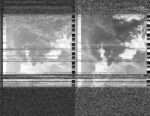
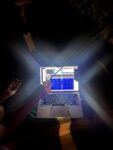
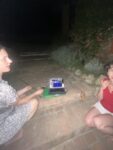
This is the first time I've picked up a NOAA satellite pass outside of NYC - I'm on a holiday with my close friends in rural Italy and it is unbelievably peaceful here - the dawn chorus/sound of cicadas at night is a far cry from the noise pollution of NYC...we just discovered a new birdsong from a Eurasian Nightjar - and it sounded like clockwork - or a faint chainsaw - it was beautiful and bizarre...I was scared we wouldn't pick up the NOAA 19 signal but after initial static it was so clear and was joyful to introduce my friends to SDR/to this methodology - one of my friends held the antenna for 15 minutes with impressive stillness - and we took a collective pause. And then to experience the decoded APT and the ephemeral cloud formations that emerged!! The last 6 minutes of the transmission were filled with static as seen on the bottom of the image - but I think I like that!
2025-06-15 21:59:00
Cyprus Amateur Radio Society (CY)
Nicosia , Cyprus
Cyprus
NOAA-19


It was a typical warm June day with a clear sky. The temperature high was around 37 degrees celcius. In general it was a good day. At the time the picture was taken a couple kids could be heard having fun in their backyard. A couple of neighbours ware also observed taking a late afternoon walk, as the temperature had subsided to about 24 degrees celcius.
2025-06-15 11:55:07
dan rhys wakefield
river thames near canary wharf, london, uk
uk
NOAA-19



I turn the corner onto the Thames Path and the sky opens out ahead of me, blue with white clouds scatted across it. The tide is at its lowest point and the river seems calm. This stretch of the river is ripe with new development in every direction and NOAA's signal weaves in and out of the towers as I listen. The pass rises to my north at Bow Creek, moving west across the sky, setting behind the new residential development under construction at Canary Wharf. The towers obscure the signal for the final minutes of the pass, so as I turn back towards the skyline all I hear is static, fading in and out of the tide as it crashes against the stone wall of the embankment.
2025-06-15 11:55:00
Goownown Growers
The Seaweed Institute
CAST, Helston, Cornwall, United Kingdom
United Kingdom
NOAA-19

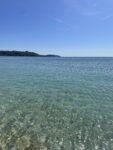
Today we had to collect washed up seaweeds for a craft workshop on seaweed pressing. We love the pressing process as a way to engage people with seaweeds.
The day is perfect and I had more time than I usually do to collect. The seaweeds best for pressing are red seaweed that tend to grow at the bottom or below the intertidal zone. When they become dislodged from their holdfasts, dying, they wash up. A northerly wind blew from the land, making the nearshore water calm – it was bliss.
Over the last half a year we have been trying to learn a little how to interpret these beautiful satellite images of familiar landmasses and unfamiliar cloud masses, not often sure what exactly we are looking at. One thing has been certain over the last few months – it’s been mostly warm and dry. We have seen many clear outlines of the cornish coast send down to us via audio file from the satellites.
It feels sadly fitting to have spent these months with our ground station, thinking more about weather, whilst the coast our work focuses on is current experiencing the warmest heat waves since records began.
Throughout April and May we have seen an ‘unprecedented’ marine heatwave in the northeastern Atlantic. The Met Office has described this heatwave as being unusual in its intensity and persistence.
The last time this was observed was in 2023, at the time the most severe marine heatwave recorded in this part of the ocean. Then, both Ruth and I were working harvesting seaweed at every low tide on The Lizard peninsular. Unaware of the data being gathered that summer, we anecdotally saw a large bleaching and dieback of our favourite seaweed Dulse. We worried about its recovery after this local marine heatwave and we wondered what data was being gathered on the effect of heat on the very shallow waters of the intertide. The Dulse seemed to recover well but we couldn’t help wonder how many of these events the ecosystem could withstand. Now working less physically close to this ecosystem, seeing more extreme marine heatwaves, we are left even more concerned for their future.
Today, whilst the tide is metres above most species, I swim in the unseasonably warm waters and gather dead floating seaweeds, a tool to teach people about the ecosystem. I wonder how many of them have died prematurely due to heat or if this is just the normal natural lifecycle.
2025-03-23 10:08:54
Richard A Carter
University of York, Campus East, United Kingdom
United Kingdom
NOAA-19
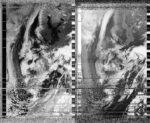
Equipment troubles finally subsided for today's pass, resulting in a pleasingly expansive view of Europe and parts of North Africa. One interesting aside is that the wind was such that it blew through small gaps in the antenna, making distinctly musical notes in the process - can imagine a speculative art project in which the antenna is turned into a sort of instrument, working alongside the distinct notes of the NOAA transmission coming in. It would be quite the composition!
2025-01-28 08:22:43
Soph Dyer
Wien, Austria
Austria
NOAA-15
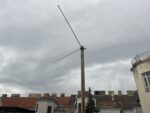
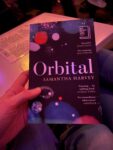
Testing, testing. Same antenna position, same satellite, different dipoles and a lower altitude pass of 54º.
Vienna Inner City weather station at 3pm:
temp. 16.8°C
relative humidity 52%
wind South, 29 km/h
precipitation [last hour] 0 mm
Sun [last hour] 19%
air pressure 997.0 hPa
Source: www.zamg.ac.at/cms/de/wetter/wetterwerte-analysen/wien
2024-06-16 22:39:42
Soph Dyer
At home, Wien, Austria
Austria
NOAA-18

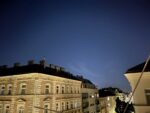
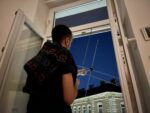
The tat tat tat of toy machine gun drifts up from the otherwise empty street.
It is warm, comfortable.
When we got home from the holiday the tomato plants were stressed from thirst and had curled their leaves from prevent water loss.
After visiting such radically different climates – the dry heat of Istria and the wet cold of Firuli – and after overhearing my sister swap farming anecdotes of a too wet, too cold spring-summer with our host in the agriturismo, I contemplate how local climate is is and the importance of grounding theories of weather knowledge in specific sites.
2024-06-17 12:37:54
Soph Dyer
At home, Wien, Austria
Austria
NOAA-18

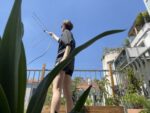
I rush out between Zooms calls to receive this satellite image on the balcony. The weather is warm dry, my mood is light, even joyful. I prop the my phone up on a potted Yuca, so as to get the tomato plants in the frame.
2024-08-27 11:52:02
Sasha Engelmann
Hackney Downs, London, United Kingdom
United Kingdom
NOAA-18

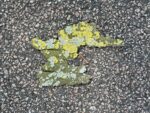
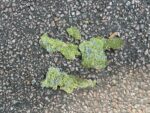
Another windy day, with gusts coming from both the south and west across Hackney Downs. Tree branches and pieces of bark have been peeled off trees and lie on the pavement or grass. Once again my tape measure Yagi was pushed and pulled around by the air, and once again I feared the delicate bits of soldering would come undone. When the dipoles bent down at odd angles, lines of noise permeated the audio recording. I realised today that I had never fully explored the fact that antennas could be malleable- able to move and bend with the wind. We associate antennas with very tall steel towers or elaborate metal sculptures that are nevertheless solid and static- but what about an antenna made of flexible material? I've been aware of 'wearable antennas' via the work of artists like Afroditi Psarra or Audrey Briot, and I have seen experiments in metal weaving, but my tape measure Yagi has raised other questions about working with semi-flexible, yet conductive materials that change rather than holding shape when exposed to air.
2024-07-18 21:38:15
Soph Dyer
Diepoldplatz, Wien, Austria
Austria
NOAA-19
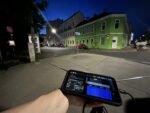
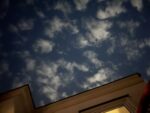
A soupy night. Warm and still. Older men on park benches smoke and watched as I point my antenna. My phone crashes multiple times. I focus on the long beans handing from the tree in front of me. The last kids of the day shouted in the park, two whizz around on scooters with LED lights in their wheels. I try to ignore the men’s gaze and relax into the warmth of the night.